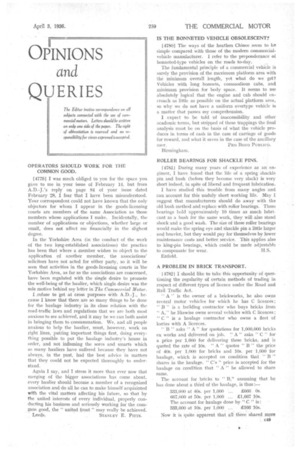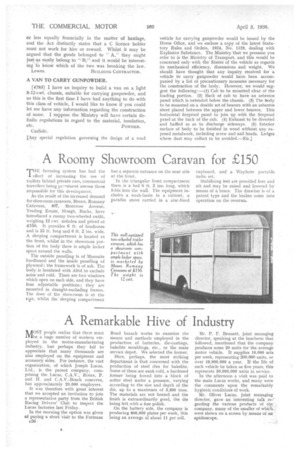OPINIONS and UERIES
Page 71

Page 72

If you've noticed an error in this article please click here to report it so we can fix it.
(4779]. I was much obliged to you for the space you gave to me in your issue of February 14, but from A.D.J.'s reply on page 84 of your issue dated February 28, I fear that 'I have been misunderstood. Your correspondent could not have known that the only objectors for whom I appear in the goods-licensing courts are members of the same Association as those members whose applications I make. Incidentally, the number of applications or objections, whether large or small, does not affect me financially in the slighest degree.
In the Yorkshire Area (in the conduct of the work of the two long-established associations) the practice has been that where a member wishes to object to the application of another member, the associations' solicitors have not acted for either party, so it Will be seen that activities in the goods-licensing courts in 'the Yorkshire Area, as far as the associations are concerned,. have been regulated with the single desire to promote the well-being of the haulier, which single desire was the sole Motive behind my letter inThe Cornmero:al Motor.
Lrefuse to get at cross purposes With A.D.-J., because I know that there. are so many things to be done for the haulage industry in its close relation with the road-traffic laws and regulations that we are both most anxious to see achieved, and it may be we can both assist in bringing them to consummation. We, and all people anxious to help the haulier, must, however, work on right lines, putting important things first, doing everything possible to put the haulage industry's house in order, and not inflaming the sores and smarts which so many hauliers have suffered because they have not always, in the past, had the best advice in matters that they could not be expected thoroughly to understand.
Again I say, and I stress it more than ever now that merging of the bigger associations has come about, every haulier should become a member of a recognized association and do all he can to make himself acqUaintecl with the vital matters affecting his future, so that by the united interests of every individual, properly con•ducting his business and seriously working for the corn-
• .mon good, the " united front" may really be achieved.
Leeds. STANLEY E. PITTS, [4780] The ways of the heathen Chinee seem to be simple compared with those of the modem commercialvehicle manufacturer. I refer to the preponderance of bonneted-type vehicles on the roads to-day. _.
The fundamental principle of a commercial vehicle is surely the provision of the maximum platform area with the minimum overall length, yet what do we get? Vehicles with long bonnets. commodious cabs, and minimum provision for body space.. It seems to me absolutely logical that the engine and cab should encroach as little as possible on the actual platform area, so why we do not have a uniform overtype vehicle is a matter that passes my comprehension.
I expect to be told of inaccessibility and -Other academic terms, but stripped of these trappings the final analysis must be on the basis of what the vehicle produces in terms of cash in the case of carriage of goods for reward, and what it saves in the case of the ancillary user. PRO BONO PUBLIC!). Birmingham.
ROLLER BEARINGS FOR SHACKLE PINS.
[4781] During many. years of experience as art, engineer, I have. found that the life of a. spring shackle pin and bush (before they become very slack) is very short indeed, in spite of liberal and frequent lubrication.
I have studied this trouble from many angles and can account for this unduly short working life. May I suggest that manufacturers should do away with the old bush method and replace with roller bearings. These bearings hold -approximately 10 times as much lubricant as a bush for the same work, they will -also stand shock and a good wash. The size of these roller bearings would make the spring eye and shackle pin a little larger and heavier, but they would pay for themselves by lower maintenance costs and better service. This applies also to king-pin bearings, which could be made adjustable
to compensate for wear. H.S. Enfield.
A PROBLEM IN BRICK TRANSPORT.
.147821 I should like to take this opportunity Of questioning the regularity of certain methods of trading in respect of different types of licence under the Road and Rail Traffic Act.
"A" is the owner of a brickworks, he also owns several motor– vehicles for which he has C licences;
"B " is a building contractor who buys bricks from " A," he likewise owns several vehicles with C licences ; "C is a haulage contractor who owns a fleet of lorries with A licences.
"B " asks " A " for quotations for 1,000,000 bricks ex works. and delivered on job. " A " asks C" for a price per 1,000 for delivering these bricks, and is quoted the rate of 10s. " A " quotes "B " the price of 40s. per 1,000 for bricks and 10s. per 1,000 'for haulage, which is accepted on condition that '" E " shares in the haulage. " C's " price is accepted for the haulage dn condition that "A " be allowed to share same.
The account for bricks to "B," assuming that he has done about a third of the haulage, is thus : 333.000 at 40s. per 1,000 £660 Os.
C167,000 at 50s. per 1,000 ...
The account for haulage done by "C "is.
333,000 at 105.. per 1;000 ... R10010s.
Now it is quite apparent that all three shared more
or less equally financially in the matter of haulage, and the Act distinctly states that a C licence holder must not work for hire or reward. Whilst it may be argued that the goods belonged to " A," they might just .as easily belong to "'B,' and it would be interesting to know which of the two was breaking the law.
Lewes. BUILDING CONTRACTOR.
A VAN TO CARRY GUNPOWDER.
[4783] I have an inquiry to build a van on a light 8-12-cwt. chassis, suitable for carrying gunpowder, and as this is the first time I have had anything to do with this class of vehicle, I would like to know if you could let me have any information regarding the construction of same. I suppose the Ministry will have certain definite regulations in regard to the material, insulation, etc. POWDER. Carlisle.
[Any special regulation governing the design of a road
vehicle for carrying gunpowder would be issued by the Home Office, and we enclose a copy of the latest Statutory. Rules and Orders, 1924, No. 1129, dealing with Explosive Substance. The Ministry that we presume you refer to is the Ministry of Transport, and this would be concerned only with the fitness of the vehicle as regards its mechanical efficiency, dimensions and weight. We should have thought that any inquiry received for a vehicle tb carry gunpowder would have been accompanied by a list of precautionary measures necessary for the construction of the body. However, we would suggest the following:—(1) Cab to be mounted clear of the loading portion. (2) Back of cab to have an asbestos panel which is extended below the chassis. (3) The body to be mounted on a double set of bearers with an asbestos sheet placed between the upper and lower .bearers. This horizontal fireproof panel to join up with the fireproof panel at the back of the cab. (4) Exhaust to be diverted and baffled so as to discharge sideways. (5) Interior • surface of body to be finished in wood without any exposed metalwork, including screw and nail heads. Ledges where dust may collect to be avoided—ED,]












































































































